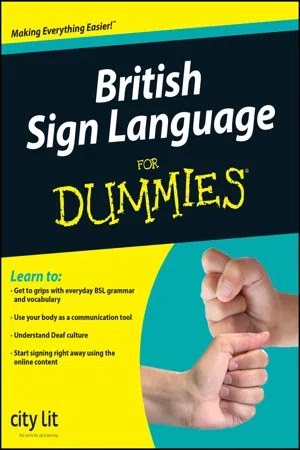Part I
Starting to Sign
In this part . . .
This Part gets you up and running with BSL. We talk in detail about the different sorts of people with hearing loss, and introduce you to the basic ground rules for good signing communication.
We also show you a few basic signs, including the BSL signs you already knew without realising.
Chapter 1
Discovering Who’s Who – And How They Communicate
In This Chapter
Looking at appropriate terms for deaf people
Communicating: how different groups of deaf people communicate in different ways
Making yourself more lipreadable
Looking at some principles of good communication
In this chapter, we talk about the different terms used to describe people who don’t hear. This is the starting point of good communication – getting the descriptions right. We look at the differences between those who describe themselves as ‘deaf’ (with a small ‘d’) and those who use ‘Deaf’ (with a big ‘D’). We look at the variety of communication tactics which you can use with different groups, and show that not all deaf people sign, and not all deaf people lipread. Knowing what’s what and being flexible will make a big difference to your whole experience of communication.
Different Groups of Deaf People
Terminology is changing all the time – that’s what happens with all living languages. In any subject there may be words that become commonly used, and those that go out-of-date . . . and some that no longer carry their original meaning at all and can even become offensive.
Who’s dumb?
Deaf-related terminology changes like that of any other language. Take ‘deaf and dumb’, for example, which was originally used to mean someone without hearing or speech. Decades ago, this was a common term and there were ‘schools for the deaf and dumb’. Older people may still use this term, but its meaning has now changed and the term can cause offence. Dumb now has another meaning, ‘stupid’, and nobody wants to be called stupid! There may be many reasons why a deaf person chooses not to use their voice – one of them being that they are a BSL user’s – and BSL is not a spoken language. Deaf-mute is also not used. It may be more appropriate to say ‘deaf without speech’ if the deaf person has chosen to use other methods of communication. True ‘muteness’ is a different matter and is not directly related to deafness.
Generally unacceptable terms to describe deaf people include: deaf and dumb, deaf-mute, stone deaf, Mutt and Jeff, special needs (a better term might be ‘have special requirements’ or ‘additional requirements/support’), non-hearing (what woman would call herself non-male, for example?) and anything with ‘-challenged’ at the end.
Understanding who’s who
So what about other terms? What terms used to describe deaf people are generally acceptable to use now, and what do they mean? The following sections cover some terms and their descriptions that you may find useful.
deaf
When you use the word deaf (with a small ‘d’) you’re referring to anyone with a hearing loss, for whatever reason, and at whatever level. The term is mostly used by deaf people who use methods other than sign language to communicate.
Out of a population of about 60 million, there are approximately 9 million in the UK who have a hearing loss to some degree. That’s 1 in 7 of the population!
Deaf
Deaf (with a capital ‘D’) is quite a different matter, and refers to the Deaf community. Just as we might use capital ‘B’ for British or ‘A’ for Australian, so a capital ‘D’ is used to show that this is about a person’s identity, not about their medical condition. The defining characteristic of a Deaf person is that they use BSL as their first or preferred language. People who are Deaf often share a common ‘Deaf culture’ which includes Deaf history, education, clubs, social events, sports (such as the Deaf Olympics) as well as sign language. Those who do not use sign language would not use the capital ‘D’ (unless of course it’s at the start of a sentence!). Sometimes you may see the term D/deaf which includes those who are ‘hearing impaired’ as well as those are part of a linguistic minority group (BSL users).
BSL is the first or preferred language of about 70,000 Deaf people in the UK.
You can be part of the Deaf community without actually being Deaf yourself. A CODA is a Child Of Deaf Adults who is hearing, but raised in the Deaf community by parents who are Deaf. A CODA is likely to be bilingual – switching easily from BSL to spoken English, but may consider BSL to be their first language.
Hard of hearing
Hard of hearing is not just a term for an old person who may be losing their hearing. You can be hard of hearing at any age for many reasons. The term tends to refer to someone with a mild or moderate hearing loss. Hard of hearing people might rely on the hearing they’ve got (residual hearing), and use technical devices such as hearing aids and loop systems to amplify the sound. A HOH person may also be relying a lot on lipreading to communicate, and has possibly joined a lipreading class to help them with this. More often than not, someone who is HOH has lost their hearing later in life, in any regards after they have acquired language. So a hard of hearing person is, a lot of the time, said to have an ‘acquired hearing loss’ rather than a ‘congenital’ one (i.e. born deaf).



